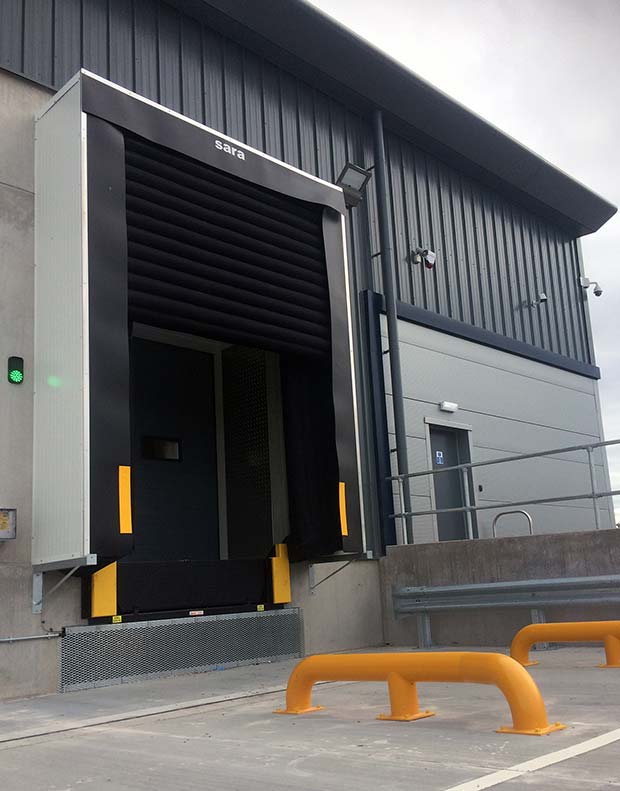The increasing pressure on the retail industry that’s created by the rise of internet shopping means efficiencies have to be driven into every stage of the operational supply chain. Alan Ryder of loading bay specialists sara LBS believes well designed loading bays will make goods handling more productive and help maintain the quality and appearance of the retail items.

Opportunities for gaining an edge over the competition are limited in retail. Discounts from wholesalers can be sought, but competitors are likely to get similar pricing levels; rent and rates are largely fixed; and staff salaries tend towards an industry norm. This means efficiencies have to be gained at an operational level, saving time and money in the distribution operation while ensuring minimum spoilage of goods in transit.
Suppliers to retailers need to make sure their loading bays are designed to meet the specific needs of their operations. For instance, big retail chains tend to use double decker trucks, so the loading bays need to be optimised to accommodate these.
Perhaps the most obvious requirement is for a tall loading bay door, typically around 5m high. If the door is too low access will be restricted, but if it is too high thermal management and biosecurity will be compromised – major issues in food handling operations.
Loading bay doors can be of several types: sectional overhead, roller shutter, curtain etc. They can also be insulated to prevent heat exchange (loss of heat in most cases, but ingress of heat in chilled environments). In retail operations most loading bay doors will be power operated, which will increase efficiency. Typically they give higher speeds of opening and closing than can be achieved with manual opening, encouraging closing between operations for thermal efficiency. In warehouses where the goods in/out process is run to tight deadlines, this speed of operation can have a tangible impact on the bottom line. In addition, the operation of powered doors can be automated, so that they open automatically once the vehicle has reversed into position and closed as it leaves.
Weather tight seals are generally required on all doors, and just about essential on larger doors. Safety features are highly recommended, including safety edges and scanners that arrest the motion of the door if personnel get too close. A simple but effective safety feature is a key safe on the door itself: the truck driver places his keys in the safe which then rises with the door until it is out of reach. This way the truck cannot be moved until the door is lowered. Other safety features that could be considered include vehicle restraints, interactive traffic lights and pedestrian barriers.
Beating the weather
It is highly recommended the apron of the loading bay has effective weather containment measures in place. This could be a fixed canopy, with or without side walls. It is important to remember that the height of the canopy is set so that the bay can accommodate the largest trucks, but if a canopy is overly high its effectiveness as weather protection will be compromised. A popular option is a retractable canopy that will contact against the top and sides of the vehicle to form a physical seal to improve thermal management and biosecurity.
In the case of food products that are sensitive to temperature, the best solution may be an inflatable canopy that forms a effective pressure seal. With these, the side and head curtains are inflated once the vehicle is in position, providing a good seal without putting any major loading on the building. With operatives working hard it is essential that consideration is given to Health & Safety. The basic principle should be to design out risks, otherwise minimise or contain them. This may mean putting windows in the loading bay doors; providing separate personal access doors, interlocks and safety cut outs to prevent doors from operating if people are close; installing a secondary curtain door to stabilise temperatures, etc.
The next level
Sometimes it is necessary to think out of the box and take loading bay design to the next level. An example of this in the retail sector was when a sara LBS client expanded and acquired new warehousing to serve northern and Scottish retail outlets.
The location of the new warehousing could honestly be described as windswept and very exposed so that cold weather was blowing in though the loading bay doors when open. sara LBS worked with the client to quickly evolve a practical solution.
Essentially the weather issue was coupled with the need for high volume, high speed use to support the retail network and online orders, so sara LBS suggested fitting an internal dock loading pod in each bay. Normally these are installed onto the external face of a building; however, here the idea was to install the pods inside the warehouse and add a retractable shelter to the outside. This would seal against the delivery vehicle to provide a weatherproof working environment. The pods would act as ‘rooms within rooms’ so heating them would be far cheaper than heating the whole areas The solution would also act as a barrier to the inclement exterior conditions.
The client liked the idea and worked with sara LBS to develop an arrangement that best suited its needs. The bays were upgraded two at a time so that normal operations could continue in the others and the improvements quickly proved popular with both operational staff and management.
SARA LBS




Comments are closed.